NVIDIA GeForce GTX 690 Review: Ultra Expensive, Ultra Rare, Ultra Fast
by Ryan Smith on May 3, 2012 9:00 AM ESTOverclocked: Power, Temperature, & Noise
Our final task is our look at GTX 690’s overclocking capabilities. NVIDIA has told us that with GTX 690 they weren’t just looking to duplicate GTX 680 SLI’s performance, but also its overclocking capabilities. This is quite the lofty goal, since with GTX 690 NVIDIA is effectively packing 2 680s into the same amount of space, leaving far less space for VRM circuitry and trace routing.
| GeForce 600 Series Overclocking | ||||
| GTX 690 | GTX 680 | |||
| Shipping Core Clock | 915MHz | 1006MHz | ||
| Shipping Max Boost Clock | 1058MHz | 1110MHz | ||
| Shipping Memory Clock | 6GHz | 6GHz | ||
| Shipping Max Boost Voltage | 1.175v | 1.175v | ||
| Overclock Core Clock | 1040MHz | 1106MHz | ||
| Overclock Max Boost Clock | 1183MHz | 1210MHz | ||
| Overclock Memory Clock | 7GHz | 6.5GHz | ||
| Overclock Max Boost Voltage | 1.175v | 1.175v | ||
In practice NVIDIA has not quite kept up with GTX 680, and in other ways completely exceeded it. When it comes to the core clock we didn’t quite reach parity with our reference GTX 680; the GTX 680’s highest boost clock bin could hit 1210MHz, while the GTX 690’s highest boost clock bin topped out at 1183MHz, some 27MHz (2%) slower.
On the other hand, our memory overclock is so high as to be within the “this doesn’t seem physically possible” range. As we have discussed time and time again, GDDR5 memory busses are difficult to run at high clocks on a good day, never mind a bad day. With GF110 NVIDIA couldn’t get too far past 4GHz, and even with GTX 680 NVIDIA was only shipping at 6GHz.
It would appear that no one has told NVIDIA’s engineers that 7GHz is supposed to be impossible, and as a result they’ve gone and done the unthinkable. Some of this is certainly down to the luck of the draw, but it doesn’t change the fact that our GTX 690 passed every last stability test we could throw at it at 7GHz. And what makes this particularly interesting is the difference between the GTX 680 and the GTX 690 – both are equipped with 6GHz GDDR5 RAM, but while the GTX 680 is equipped with Hynix the GTX 690 is equipped with Samsung. Perhaps the key to all of this is the Samsung RAM?
In any case, our final result was a +125MHz core clock offset and a +1000MHz memory clock offset, which translates into a base clock of 1040MHz, a max boost clock of 1183MHz, and a memory clock of 7GHz. This represents a 12%-14% core overclock and a 17% memory overclock, which is going to be enough to put quite the pep in the GTX 690’s step.
As always we’re going to start our look at overclocking in reverse, beginning with power, temperature, and noise. For the purpose of our testing we’ve tested our GTX 690 at two different settings: at stock clocks with the power target set to 135% (GTX 690 PT), and with our custom overclock alongside the same 135% power target (GTX 690 OC). This allows us to look at both full overclocking and the safer option of merely maxing out the boost clocks for all they’re worth.
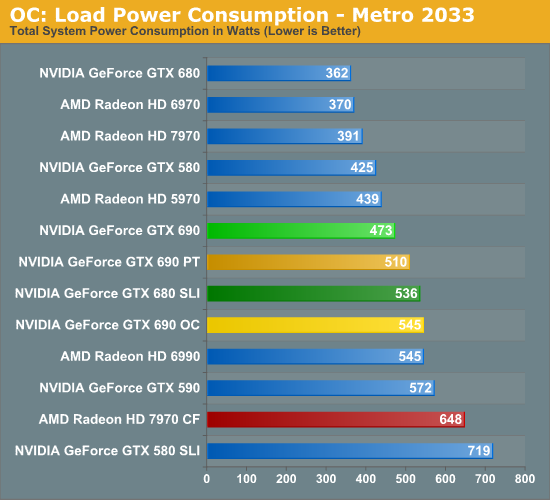

As expected, merely increasing the power target to 135% was enough to increase the GTX 690’s power consumption, though overclocking further adds to that. Even with the power target increase however, the power consumption at the wall for the GTX 690 is still lower than the GTX 680 SLI by over 20W, which is quite impressive. As we’ll see in our section on performance this is more than enough to erase the GTX 690’s performance gap, meaning at this point its still consuming less power than the GTX 680 SLI while offering better performance than its dual-card cousin.
It’s only after outright overclocking that we finally see power consumption equalize with the GTX 680 SLI. The overclocked GTX 690 is within 10W of the GTX 680 SLI, though as we’ll see the performance is notably higher.
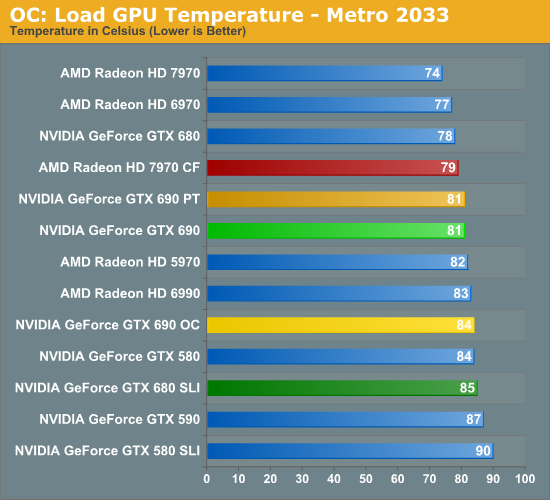
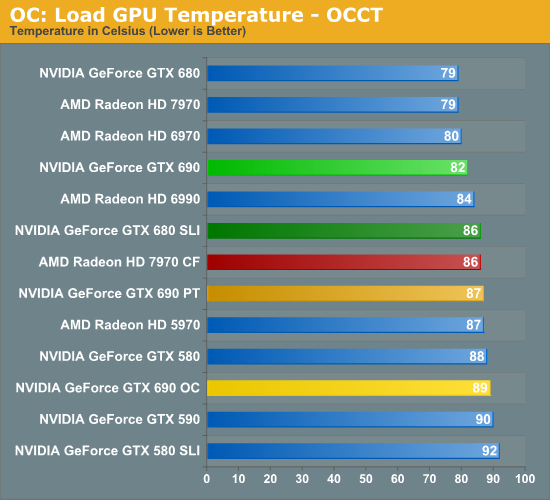
What does playing with clocks and the power target do to temperatures? The impact isn’t particularly bad, though we’re definitely reaching the highest temperatures we really want to hit. For the GTX 690 PT things are actually quite good under Metro, with the temperature not budging an inch even with the higher power consumption. Under OCCT however temperatures have risen 5C to 87C. Meanwhile the GTX 690 OC reaches 84C under Metro and a toasty 89C under Metro. These should be safe temperatures, but I would not want to cross 90C for any extended period of time.
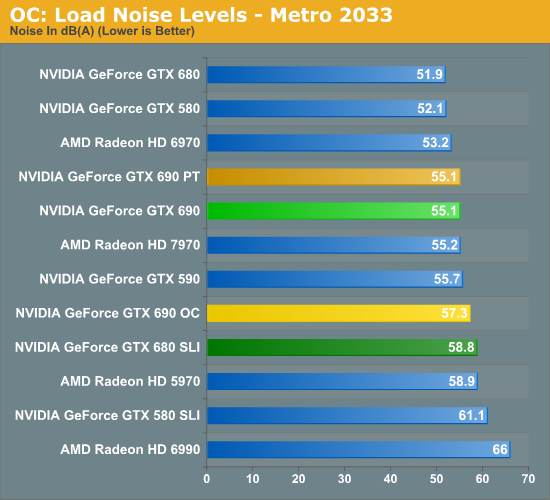
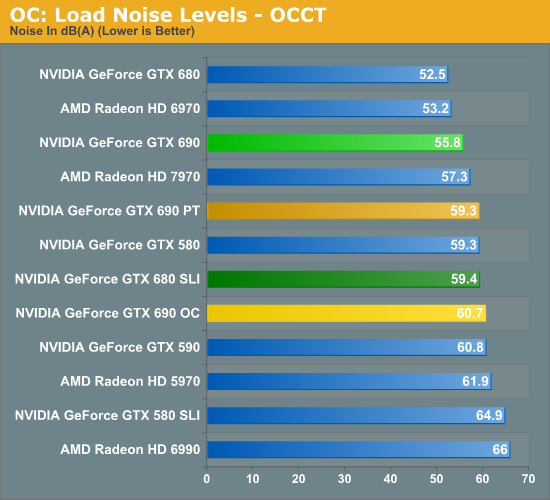
Finally we have load noise. Unsurprisingly, because load temperatures did not go up for the GTX 690 PT under Metro load noise has not gone up either. On the other hand load noise under OCCT has gone up 3.5dB, making the GTX 690 PT just as loud as our GTX 680 SLI in its adjacent configuration. In practice the noise impact from raising the power target is going trend closer to Metro than OCCT, but Metro is likely an overly optimistic scenario; there’s going to be at least a small increase in noise here.
The GTX 690 OC meanwhile approaches the noise level of the GTX 680 SLI under Metro, and shoots past it under OCCT. Considering the performance payoff some users will no doubt find this worth the noise, but it should be clear that overclocking like this means sacrificing the stock GTX 690’s quietness.










200 Comments
View All Comments
CeriseCogburn - Thursday, May 3, 2012 - link
Keep laughing, this card cannot solid v-sync 60 at that "tiny panel" with only 4xaa in the amd fans revived favorite game crysis.Can't do it at 1920X guy.
I guess you guys all like turning down your tiny cheap cards settings all the time, even with your cheapo panels?
I mean this one can't even keep up at 1920X, gotta turn down the in game settings, keep the CP tweaked and eased off, etc.
What's wrong with you guys ?
What don't you get ?
nathanddrews - Thursday, May 3, 2012 - link
Currently the only native 120Hz displays (true 120Hz input, not 60Hz frame doubling) are 1920x1080. If you want VSYNC @ 120Hz, then you need to be able to hit at least 120fps @ 1080p. Even the GTX690 fails to do that at maximum quality settings on some games...CeriseCogburn - Thursday, May 3, 2012 - link
It can't do 60 v-sync at 1920 in crysis, and that's only on 4xaa.These people don't own a single high end card, that's for sure, or something is wrong with their brains.
nathanddrews - Thursday, May 3, 2012 - link
You must be talking about minimum fps, because on Page 5 the GTX690 is clearly averaging 85fps @1080p.Tom's Hardware (love 'em or hate 'em) has benchmarks with AA enabled and disabled. Maximum quality with AA disabled seems to be the best way to get 120fps in nearly every game @ 1080p with this card.
CeriseCogburn - Friday, May 4, 2012 - link
You must be ignoring v-sync and stutter with frames that drop below 60, and forget 120 frames a sec.Just turn down the eye candy... on the 3 year old console ports, that are "holding us back"... at 1920X resolutions.
Those are the facts, combined with the moaning about ported console games.
Ignore those facts and you can rant and wide eye spew like others - now not only is there enough money for $500 card(s)/$1000dual, there's extra money for high end monitors when the current 1920X pukes out even the 690 and CF 7970 - on the old console port games.
Whatever, everyone can continue to bloviate that these cards destroy 1920X, until they look at the held back settings benches and actually engage their brains for once.
hechacker1 - Thursday, May 3, 2012 - link
Well not if you want to do consistent 120FPS gaming. Then you need all the horsepower you can get.Hell my 6970 struggles to maintain 120FPS, and thus makes the game choppy, even though it's only dipping to 80fps or so.
So now that I have a 120FPS monitor, it's incredibly easy to see stutters in game performance.
Time for an upgrade (1080p btw).
Sabresiberian - Thursday, May 3, 2012 - link
Actually, they use the 5760x1200 because most of us Anandtech readers prefer the 1920x1200 monitors, not because they are trying to play favorites.CeriseCogburn - Thursday, May 3, 2012 - link
Those monitors are very rare. Of course none of you have even one.Traciatim - Thursday, May 3, 2012 - link
My monitor runs 1920x1200, and I specifically went out of my way to get 16:10 instead of 16:9. You fail.CeriseCogburn - Friday, May 4, 2012 - link
Yes you went out of your way, why did you have to they are so common, I'm sure you did.In any case, since they are so rare the bias is still present here as shown.